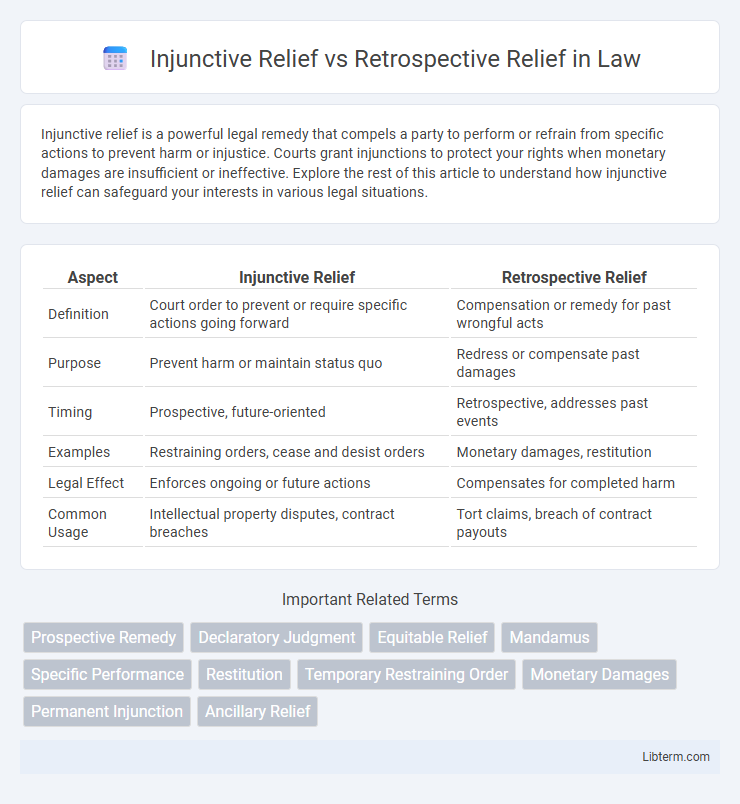Injunctive relief is a powerful legal remedy that compels a party to perform or refrain from specific actions to prevent harm or injustice. Courts grant injunctions to protect your rights when monetary damages are insufficient or ineffective. Explore the rest of this article to understand how injunctive relief can safeguard your interests in various legal situations.
Table of Comparison
| Aspect | Injunctive Relief | Retrospective Relief |
|---|---|---|
| Definition | Court order to prevent or require specific actions going forward | Compensation or remedy for past wrongful acts |
| Purpose | Prevent harm or maintain status quo | Redress or compensate past damages |
| Timing | Prospective, future-oriented | Retrospective, addresses past events |
| Examples | Restraining orders, cease and desist orders | Monetary damages, restitution |
| Legal Effect | Enforces ongoing or future actions | Compensates for completed harm |
| Common Usage | Intellectual property disputes, contract breaches | Tort claims, breach of contract payouts |
Introduction to Injunctive Relief and Retrospective Relief
Injunctive relief is a court-ordered remedy requiring a party to do or refrain from specific actions to prevent ongoing or future harm. Retrospective relief, in contrast, addresses past wrongs by compensating for damages already incurred, often through monetary awards. Understanding the distinction aids in selecting effective legal strategies to either halt wrongful conduct or remedy previous losses.
Defining Injunctive Relief: Meaning and Purpose
Injunctive relief is a court-ordered remedy that requires a party to do or refrain from specific acts to prevent ongoing or future harm, serving as a preventive measure rather than a compensation for past actions. It is designed to maintain the status quo and avoid irreparable damage that monetary damages cannot adequately address. This relief plays a critical role in disputes involving intellectual property, contract violations, and environmental protection where immediate action is necessary.
Understanding Retrospective Relief: Scope and Impact
Retrospective relief refers to legal remedies that address past actions or conduct, typically through monetary compensation or corrective orders based on events that have already occurred. Its scope includes rectifying harms caused by violations of rights or contractual obligations, often involving damages or restitution to restore the injured party to their original position. The impact of retrospective relief lies in compensating losses and deterring future misconduct by holding wrongdoers accountable for past behavior.
Key Differences Between Injunctive and Retrospective Relief
Injunctive relief involves court-ordered actions to prevent ongoing or future harm, while retrospective relief compensates for harm or damages already incurred. Injunctive relief is proactive and focuses on stopping or mandating behavior, whereas retrospective relief is reactive, providing monetary or other forms of compensation after the fact. The key difference lies in timing and purpose: injunctive relief is preventative, and retrospective relief is remedial.
Legal Basis for Injunctive Relief in Civil Litigation
Injunctive relief is grounded in equitable principles that allow courts to order parties to act or refrain from specific actions to prevent irreparable harm, based on established statutes and common law precedents in civil litigation. This form of relief is typically granted when monetary damages are insufficient and immediate intervention is necessary to maintain the status quo or avoid ongoing injury. Courts consider factors such as likelihood of success on the merits, potential for irreparable harm, balance of equities, and public interest to determine the appropriateness of injunctive relief.
Legal Basis for Retrospective Relief in Civil Litigation
Retrospective relief in civil litigation is grounded primarily in equitable principles that aim to restore parties to their original position before the wrongful act occurred. Courts grant retrospective relief, such as compensatory damages or restitution, based on established legal doctrines including unjust enrichment and breach of contract. This form of relief contrasts with injunctive relief by focusing on redressing past harm rather than preventing future violations, relying on statutory provisions and case law that authorize monetary or declaratory remedies to remedy completed wrongful acts.
Common Scenarios Requiring Injunctive Relief
Common scenarios requiring injunctive relief include preventing ongoing contractual breaches, stopping trademark or copyright infringement, and halting property damage or trespass. Courts grant injunctive relief to maintain the status quo and avoid irreparable harm that monetary damages cannot remedy. This equitable remedy is essential in cases where immediate action is necessary to prevent further legal violations or harm.
Typical Cases Where Retrospective Relief is Sought
Retrospective relief is commonly sought in cases involving contract breaches, where monetary compensation aims to restore the injured party to the position they occupied before the breach occurred. Intellectual property disputes often utilize retrospective relief to address unauthorized use or infringement that caused past harm. Employment law cases, particularly wrongful termination or discrimination claims, frequently pursue retrospective relief to remedy financial losses or damages experienced by the employee.
Pros and Cons of Injunctive vs Retrospective Relief
Injunctive relief prevents ongoing or future harm by compelling or restraining specific actions, offering timely protection but sometimes causing immediate disruption or hardship for the parties involved. Retrospective relief, which typically involves monetary compensation or restoration, addresses past damages and provides a clear measure of loss recovery but may fail to prevent further harm if the wrongful conduct continues. Choosing between injunctive and retrospective relief depends on the urgency of preventing continued injury versus securing reparations for damages already incurred.
Choosing the Right Type of Relief: Legal Considerations
Choosing between injunctive relief and retrospective relief hinges on the nature of the legal dispute and desired outcome. Injunctive relief is suited for preventing ongoing or imminent harm by ordering a party to act or refrain from specific conduct, while retrospective relief, often in the form of monetary damages, compensates for past harms or breaches. Legal considerations include the urgency of harm, feasibility of enforcement, availability of damages, and the court's ability to issue equitable remedies aligned with the case facts.
Injunctive Relief Infographic

 libterm.com
libterm.com